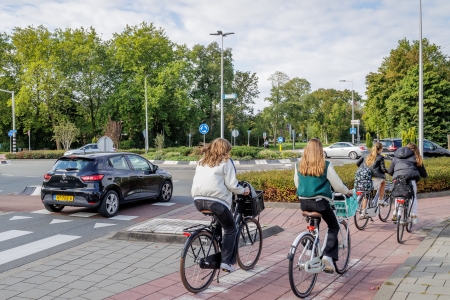Ban on handheld phone use while cycling
Since July 2019, use of handheld phones or other electronic communication and information processing devices while cycling has been prohibited [33]. In 2021, this legislative amendment was evaluated by means of a questionnaire [34]. This showed that one in five cycling youngsters aged 12 to 17 indicates having thereafter used their phone less often. This corresponds to the research findings of TeamAlert & Samsung [35] which shows that, since then, four out of five youngsters aged 12 to 24 (most of them aged 15 to 18) have still used their phones while cycling. It is unknown whether the slight decrease in phone use by young cyclists has also resulted in fewer crashes.
Education
Traffic education is either formal or informal. Formal education is a legally required component of lessons, for example at primary schools. Not much is known about the effect of traffic education; an effect on crash risk has not yet been proven. Some evaluations, however, show that traffic education may affect (self-reported) behaviour or attitudes, provided the programme was well designed. The features of a well-designed programme (and more about traffic education) can be found in SWOV fact sheet Traffic education.
Informal traffic education is taken care of in daily life, for example by parents. Young road users gain hands-on experience while their parents point out potential hazards on the way home. Accompanied driving (2toDrive), when adolescents drive accompanied by a supervising adult, is an example of informal education (see SWOV fact sheet Driver training and driving tests).
Cycling mode & PhoNo
In the Netherlands, several interventions have been developed to discourage phone use among young cyclists. Their effectiveness is unknown. In late 2014, insurance company Interpolis introduced a cyclist app called ‘Fietsmodus' (Cycling mode). The app aimed to discourage smartphone use by young cyclists, by awarding credit points when the app was active and the phone was not used. The effect of the app was not studied. In addition, Interpolis developed the PhoNo app in 2019, again aiming to reduce smartphone use by young cyclists. A SWOV evaluation [36] showed that, although participants evaluated the app favourably, the effects on smartphone use by young cyclists was not clear. The uncertainty was partially caused by findings that were inconsistent and hard to interpret.
Moped licence
In 2006, the moped certificate was replaced by the moped licence. This mainly affected moped ownership. The number of (light) moped casualties decreased relatively soon after licence introduction, as a direct consequence of the decrease of young (light) moped riders [37]. but not in statistically significant numbers. For more information, see SWOV fact sheet Moped and light-moped riders.
